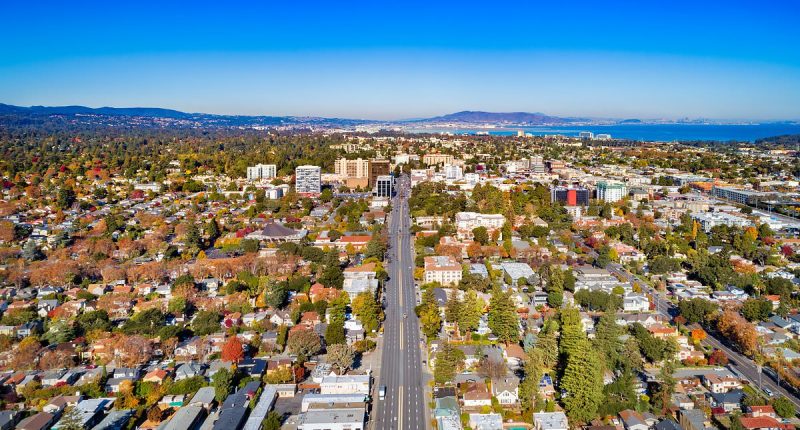Share this @internewscast.com
A six-figure salary could buy a house, a comfortable lifestyle, and perhaps even a sense of financial security in most places around the US.
But in California’s Bay Area, home to tech titans, leafy suburbs, and soaring costs, that same salary can qualify families as low income.
As per the latest data shared by the California Department of Housing and Community Development (HCD), the criteria for being labeled as ‘low income’ in the Bay Area’s nine counties has climbed so significantly that families making over $150,000 annually are still eligible for housing assistance programs.
In Santa Clara County, the heart of Silicon Valley, a family-of-four making $159,000 is labeled low income by the state by official standards.
In the counties of San Francisco, San Mateo, and Marin, where modern condo towers stand alongside homeless encampments, the income cap for a family of four to be considered low-income is $156,000.
At the same time, the median price of a single-family home throughout this area reached $1.4 million in March, which is a 12% rise from the previous month, reports the California Association of Realtors.
In San Mateo County, the median sale price was even higher at $2 million for a single-family home.
This means that even dual-income professional households such as teachers, nurses, tech workers are increasingly being priced out, despite earning well above what used to be considered a middle-class income.

In Santa Clara County, the heart of Silicon Valley, a family of four making $159,000 is officially labeled low income by the state. Pictured, downtown Palo Alto

In San Francisco, San Mateo, and Marin counties, where gleaming glass condos tower over homeless tent encampments, the low-income limit sits at $156,000 for a family of four. Pictured, San Francisco Bay and the city of San Francisco
In Solano County, which remains the region’s most ‘affordable,’ the area median income is $124,600.
A household of four earning more than $94,500 still meets the low-income criteria. In Sonoma, it’s $105,600 while in Napa, it’s $117,400.
These figures which staggeringly high by national standards, are merely the floor for being considered financially strained in the Bay Area.
Nationally the median household income in 2023 was about $75,000, according to the US Census Bureau.
California defines ‘low income’ as 80% or less of a county’s Area Median Income (AMI).
However, because the AMIs have ballooned due to explosive wealth at the top, those at the bottom, even those making six figures, are being crushed under the weight of housing costs.
While the data is intended to determine eligibility for affordable housing programs, it paints a portrait of a region in crisis where people can earn good salaries but still not afford to live in the city where they work.

A household of four earning more than $94,500 still meets the low-income criteria. In Sonoma, it’s $105,600 while in Napa, it’s $117,400. Pictured, Vineyards in Napa Valley, California

Marin County sits across the Golden Gate Strait from San Francisco. Pictured, the historic Spanish Colonial mission and downtown skyline of San Rafael, California

Rio Vista in Solano County is considered one of the most affordable places in the San Francisco Bay Area to buy or build new homes. Pictured, wind turbines spinning in the Montezuma Hills in the delta region of Northern California just outside Rio Vista
Despite years of promises from governors and lawmakers to tackle the housing shortage, progress has been incremental at best.
Governor Gavin Newsom vowed in 2019 to build 3.5 million homes by 2025. By late 2023, fewer than 500,000 had been permitted.
A recent report by the nonpartisan Legislative Analyst’s Office gave California an ‘F’ in housing affordability, citing a shortfall of at least 2.5 million units.
Even when affordable housing projects are approved, they often come with income caps that don’t reflect the new reality.
A family of four earning $150,000 may now be ‘too rich’ for subsidized units, but too poor to buy a market-rate home or pay $5,000 in monthly rent.
The pandemic only made the situation worse as remote workers snapped up homes in formerly cheaper counties like Sonoma and Solano, pushing prices up.
At the same time, high interest rates have kept many potential sellers on the sidelines, tightening inventory and creating bidding wars once more.

Essential workers such as teachers, paramedics and utility workers are being forced into longer commutes, moving away from the cities they serve. Pictured, the famous painted ladies, Victorian and Edwardian houses in San Francisco
It means essential workers such as teachers, paramedics and utility workers are being forced into longer commutes, moving away from the cities they serve. Others simply decide to leave altogether.
In 2022 alone, more than 500,000 people left California, with the Bay Area seeing the steepest population declines.
The HCD has tried to adapt. Its updated guidelines account for family size and cost-of-living, and are used to determine rent caps and eligibility for aid programs.

















